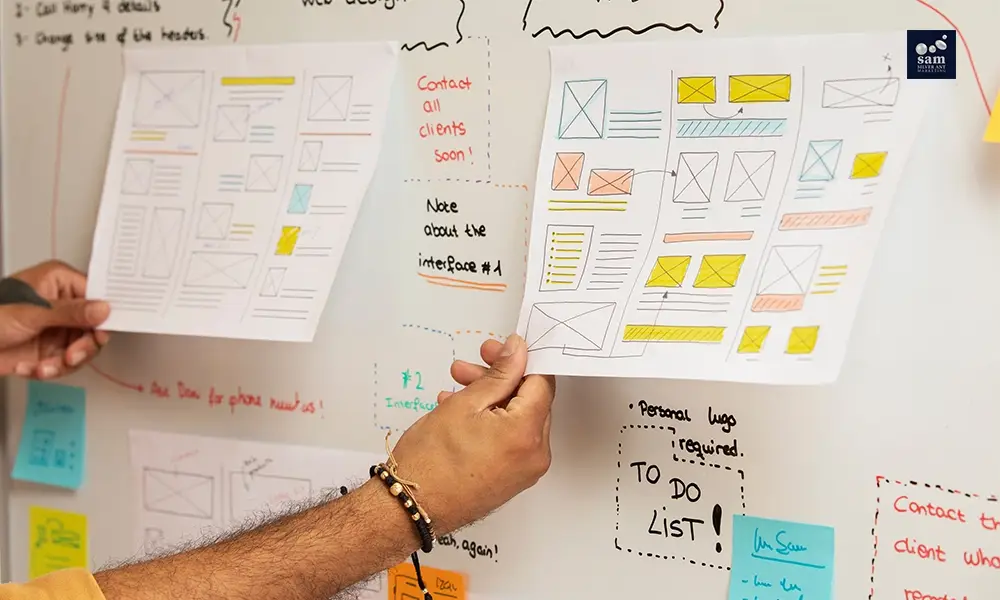Each piece of content you release has the potential to be a potent educator and motivator that appeals to your prospect’s emotions. Whether it’s blogs, articles, eBooks, case studies, landing pages, infographics, videos—you name it—your content can engage readers at the right moment and location.
The secret to making sure this happens? Content Mapping.
Why Content Mapping Matters More Than Ever in 2025
Stat Insight (2025): Businesses that strategically map their content to the buyer’s journey generate 72% more leads and experience 55% higher conversion rates compared to those without a content strategy (Content Marketing Institute).
In today’s saturated digital space, random content creation just doesn’t cut it anymore. Brands that personalize the buyer’s experience through strategic content are the ones thriving.
FOMO Alert:
If you’re not actively mapping your content in 2025, you’re falling behind competitors who are turning clicks into customers faster than ever before.
What is Content Mapping?
Content Mapping means developing a content strategy that targets consumers at every stage of the buying process. Any content marketing plan must include this approach to divide the burden and utilize various parts for different goals. Content mapping is the process of arranging material according to the user’s demands at each point of the journey with the ultimate objective of promoting conversions. An effective content strategy includes content mapping as a crucial component.
It involves:
- ✅ Dividing your content workload smartly
- ✅ Using various formats for different goals
- ✅ Aligning content to your audience’s needs and buying stage
Ultimately, it’s about promoting conversions by offering the right content at the right time. An effective content marketing strategy today must have content mapping at its core.
The Content Mapping Process: Key Questions for Success
Your company’s goals determine the purpose of your content mapping. However, creating a tailored experience for your audience remains the ultimate aim.
Marketing Insight: A well-structured content map leads to 3X better customer retention rates and boosts content ROI significantly (HubSpot 2025 Marketing Report).
Why You Must Do Content Mapping for a Website
| Benefit | How It Helps |
|---|---|
| Targeted Content | Create specific content for every buying stage |
| Maximize ROI | Extract more value from each content piece |
| Boost Engagement | Build stronger connections and loyalty |
| Drive Conversions | Align content perfectly with buyer intent |
Let’s break it down:
Create More Relevant Content for Each Buying Stage
Craft blog posts, landing pages, and case studies tailored to where customers are in their journey. Deliver the right message at the right time to nurture leads more effectively. This approach moves prospects closer to conversion with less friction.
Get More Returns From Every Content Piece
Every content asset will have a clear purpose aligned with customer needs. Instead of creating content randomly, you maximize the impact of each piece. This smarter strategy leads to better engagement and higher ROI.
Foster Engaged, Loyal Customers
Delivering valuable content at every stage builds trust and loyalty naturally. Customers who feel supported throughout their journey are more likely to stay and advocate for your brand. Engaged customers are your most powerful promoters.
How Content Mapping Supercharges Your Marketing Strategy
Content mapping isn’t just a tactic; it’s your marketing lifeline.
It ensures that content speaks to the audience’s needs at exactly the right moment—increasing trust, shortening sales cycles, and skyrocketing engagement.
Smart Tip:
Map content against the “5W Framework”:
- ✅ What content to create
- ✅ Who the audience is
- ✅ Where they engage
- ✅ When to publish
- ✅ Why it matters
Brands that integrate content mapping outperform their competitors by up to 67% in sales growth (DemandGen Report 2025).
How to Create a Content Map
A content map outlines how your brand reaches potential clients at every step of their journey.
Here’s a clear step-by-step table:
| Step | Action |
|---|---|
| 1 | Research your audience & create personas |
| 2 | Map buying stages for each persona |
| 3 | Brainstorm content types & topics |
| 4 | Audit existing content & identify gaps |
| 5 | Plan and prioritize content creation |
Step-by-Step Content Mapping Guide
Who: Research Your Audience and Create Personas
Your target audience is everything.
Use tools like Google Analytics, SEMrush, and Surveys to gather real-world data.
Then, create customer personas that reflect these insights.
Example Persona Table:
| Persona | Goals | Challenges |
|---|---|---|
| Startup Founder Sarah | Growth, Funding | Marketing knowledge gap |
| E-commerce Manager Ethan | Increase Sales | High customer churn |
Pro Tip: The more detailed your persona, the better your content will resonate.
What: Map out the buying stages of your persona(s)
Stages of the Buyer’s Journey:
| Stage | Focus | Content Ideas |
|---|---|---|
| Awareness | Problem recognition | Blogs, eBooks, Social Posts |
| Consideration | Research solutions | Webinars, Whitepapers, Case Studies |
| Decision | Final choice | Product Demos, Testimonials, Landing Pages |
Each persona will face unique questions and challenges at every stage. Craft your content to answer those questions proactively.
Where/When: Match Content Types to Each Buyer Stage
| Stage | Content Formats | Example Topics |
|---|---|---|
| Awareness | Blogs, Social Media, Checklists | “Top 10 Time Management Hacks” |
| Consideration | Webinars, Case Studies, Whitepapers | “Best CRM Solutions for 2025” |
| Decision | Testimonials, Demos, Pricing Pages | “Why Companies Choose Us for SaaS Integration” |
Awareness content
Your awareness material should inform your audience. It needs to assist them in recognizing and comprehending an issue, the significance of it, and the best course of action.
Types of content: Content types include social media postings, blogs, ebooks, checklists, infographics, and how-to instructions.
Content Mapping Examples of awareness topics:
- BetterUp’s “10 Ways to Take Time for Yourself”
- Mint’s Guide to Money Saving
Consideration content
Your consideration material should assist your viewers in making decisions. You may educate students to compare and contrast every solution for a given issue. Alternatively, inform them about a certain approach and why it works best.
Idea content types: Content types include tutorials, webinars, case studies, white papers, product comparisons and evaluations, and how-to manuals.
Content Mapping Examples of consideration topics:
- LocaliQ’s 20 Ways to Increase Website Visibility
- Greatest Down Comforters for 2024
Decision content
Convincing your audience that your product or service best fits their requirements is the main goal of decision content. This is more about communicating the value and advantages of what you have to offer in a way that showcases your experience than it is about making sales pitches.
Idea content types: Content types include case studies, product features, testimonials and reviews, and landing pages.
Examples of decision topics:
- Web flow’s landing page
- 12 Things That Only Ahrefs Can Do
How: Use your content map to evaluate existing content/plan new content
Use your content map to audit your existing assets.
Ask:
- ✅ Persona Gaps: Identify which key personas haven’t been covered yet.
- ✅ Full Buyer Journey: Ensure all buyer stages (Awareness, Consideration, Decision) are represented in your content strategy.
- ✅ 2025 Content Relevance: Review existing content and determine which pieces need to be updated with current trends, data, and best practices for 2025.
Then, prioritize content creation to fill in the gaps.
A content map is a terrific tool for helping you get an overview of all the material you’ve previously created and how each piece benefits customers. This can assist you in identifying any gaps that need to be filled and reach more consumers at a stage you might be neglecting.
Tools to Help:
- 🎯 Trello/Asana for content planning
- 🎯 SEMrush Content Audit Tool
- 🎯 HubSpot Content Strategy Tool
Conclusion: Win Customers With a Smart Content Map
At first, content mapping may seem overwhelming.
But the brands winning in 2025? They’re the ones obsessed with understanding their customers and delivering laser-targeted content.
Action Tip:
Master content mapping now to:
- 🎯 Build stronger customer relationships
- 🎯 Maximize content ROI
- 🎯 Future-proof your marketing efforts
Your content map isn’t just a document—it’s the blueprint for lasting success in today’s competitive digital landscape.
Ready to take your content strategy to the next level?
Visit Silver Ant Marketing to learn how we can help you create a winning content map and drive measurable results.





